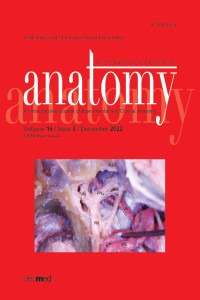Abstract
References
- Gülekon IN, Turgut HB. The external occipital protuberance: can it be used as a criterion in the determination of sex? J Forensic Sci 2003;48:513–6.
- Matsumoto M, Okada E, Ichihara D, Watanabe K, Chiba K, Toyama Y, Fujiwara H, Momoshima S, Nishiwaki Y, Hashimoto T, Takahata T. Age-related changes of thoracic and cervical intervertebral discs in asymptomatic subjects. Spine (Phila Pa 1976) 2010;35:1359–64.
- Shahar D, Sayers MGL. A morphological adaptation? The prevalence of enlarged external occipital protuberance in young adults. J Anat 2016;229:286–91.
- Rogers SA, Drage N, Durning P. Incidental findings arising with cone-beam computed tomography imaging of the orthodontic patient. Angle Orthod 2011;81:350–5.
- Cha JY, Mah J, Sinclair P. Incidental findings in the maxillofacial area with 3-dimensional cone-beam imaging. Am J Orthod Dentofacial Orthop 2007;132:7–14.
- Srivastava M, Asghar A, Srivastava NN, Gupta N, Jain A, Verma J. An anatomic morphological study of occipital spurs in human skulls. J Craniofac Surg 2018;29:217–9.
- Varghese E, Samson RS, Kumbargere SN, Pothen M. Occipital spur: understanding a normal yet symptomatic variant from orthodontic diagnostic lateral cephalogram. BMJ Case Rep 2017; bcr2017220506.
- Gómez Zubiaur A, Alfageme F, López-Negrete E, Roustan G. Type 3 external occipital protuberance (spine type): ultrasonographic diagnosis of an uncommon cause of subcutaneous scalp pseudotumor in adolescents. Actas Dermosifiliogr (Engl Ed) 2019;110:774–5.
- Jacques T, Jaouen A, Kuchcinski G, Badr S, Demondion X, Cotten A. Enlarged external occipital protuberance in young French individuals’ head CT: stability in prevalence, size and type between 2011 and 2019. Sci Rep 2020;10:6518.
- Jung PK, Lee GC, Moon CH. Comparison of cone-beam computed tomography cephalometric measurements using a midsagittal projection and conventional two-dimensional cephalometric measurements. Korean J Orthod 2015;45:282–8.
- Li G. Patient radiation dose and protection from cone-beam computed tomography. Imaging Sci Dent 2013;43:63–9.
- Sattur M, Korson C, Henderson F Jr, Kalhorn S. Presentation and management of traumatic occipital spur fracture. Am J Emerg Med 2019;37:1005.e1-1005.e2.
Abstract
Exaggerated bony outgrowth of the external occipital protuberance is called occipital spur. The current report presents a case of a 20-year-old male patient seeking orthodontic treatment. The patient was referred for a cone-beam computed tomography scan to determine the position of impacted maxillary canines. An incidental finding on the scan was the existence of a focal spine-like hyperostosis in the occipital protuberance, and confirmed to be an occipital spur (Type III spine form). Clinical examination showed a palpable bone swelling without any tenderness, infection or discharge. He was referred to an orthopaedic surgeon should any symptoms get aggravated in the future. This case supports the essential role of cone-beam computed tomography to detect, analyse and identify the lesion as an occipital spur. This is the first such case report of its kind, which measures the size of occipital spur using cone-beam computed tomography and 3D imaging software. Usually asymptomatic, awareness of this uncommon presentation can expedite emergency medical care in the event of pain, or trauma leading to fracture or avulsion of the spur fragment. In such an event, the readily available CBCT data will be indispensable to surgeons for planning surgery with precise linear and volumetric measurements. Knowledge of these bony spurs is of untold value to anatomists, who will benefit greatly from being able to study the variants in vivo, in addition to studies on dry skulls or preserved cadavers. It is also of interest to clinicians and radiologists for diagnostic purposes, and sports physicians.
Keywords
Cone-beam computed tomography (CBCT) external occipital protuberance inion hook occipital spur
References
- Gülekon IN, Turgut HB. The external occipital protuberance: can it be used as a criterion in the determination of sex? J Forensic Sci 2003;48:513–6.
- Matsumoto M, Okada E, Ichihara D, Watanabe K, Chiba K, Toyama Y, Fujiwara H, Momoshima S, Nishiwaki Y, Hashimoto T, Takahata T. Age-related changes of thoracic and cervical intervertebral discs in asymptomatic subjects. Spine (Phila Pa 1976) 2010;35:1359–64.
- Shahar D, Sayers MGL. A morphological adaptation? The prevalence of enlarged external occipital protuberance in young adults. J Anat 2016;229:286–91.
- Rogers SA, Drage N, Durning P. Incidental findings arising with cone-beam computed tomography imaging of the orthodontic patient. Angle Orthod 2011;81:350–5.
- Cha JY, Mah J, Sinclair P. Incidental findings in the maxillofacial area with 3-dimensional cone-beam imaging. Am J Orthod Dentofacial Orthop 2007;132:7–14.
- Srivastava M, Asghar A, Srivastava NN, Gupta N, Jain A, Verma J. An anatomic morphological study of occipital spurs in human skulls. J Craniofac Surg 2018;29:217–9.
- Varghese E, Samson RS, Kumbargere SN, Pothen M. Occipital spur: understanding a normal yet symptomatic variant from orthodontic diagnostic lateral cephalogram. BMJ Case Rep 2017; bcr2017220506.
- Gómez Zubiaur A, Alfageme F, López-Negrete E, Roustan G. Type 3 external occipital protuberance (spine type): ultrasonographic diagnosis of an uncommon cause of subcutaneous scalp pseudotumor in adolescents. Actas Dermosifiliogr (Engl Ed) 2019;110:774–5.
- Jacques T, Jaouen A, Kuchcinski G, Badr S, Demondion X, Cotten A. Enlarged external occipital protuberance in young French individuals’ head CT: stability in prevalence, size and type between 2011 and 2019. Sci Rep 2020;10:6518.
- Jung PK, Lee GC, Moon CH. Comparison of cone-beam computed tomography cephalometric measurements using a midsagittal projection and conventional two-dimensional cephalometric measurements. Korean J Orthod 2015;45:282–8.
- Li G. Patient radiation dose and protection from cone-beam computed tomography. Imaging Sci Dent 2013;43:63–9.
- Sattur M, Korson C, Henderson F Jr, Kalhorn S. Presentation and management of traumatic occipital spur fracture. Am J Emerg Med 2019;37:1005.e1-1005.e2.
Details
| Primary Language | English |
|---|---|
| Subjects | Radiology and Organ Imaging |
| Journal Section | Case Reports |
| Authors | |
| Publication Date | December 20, 2022 |
| Published in Issue | Year 2022 Volume: 16 Issue: 3 |
Cite
Anatomy is the official journal of Turkish Society of Anatomy and Clinical Anatomy (TSACA).


